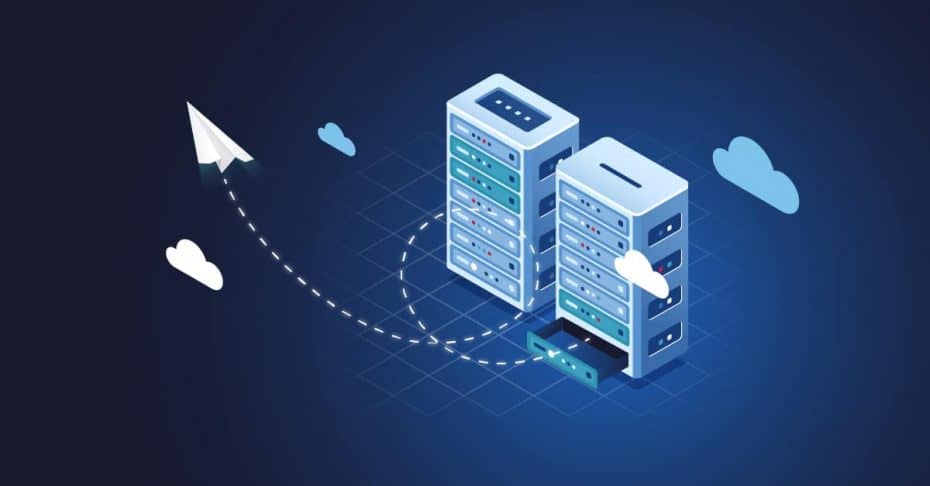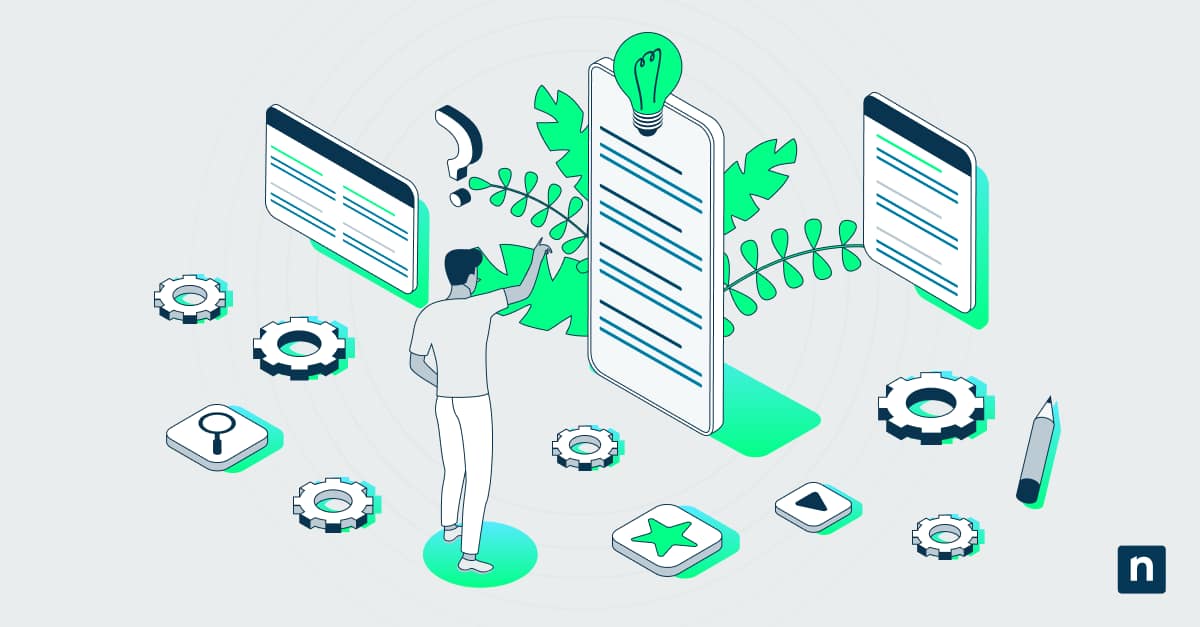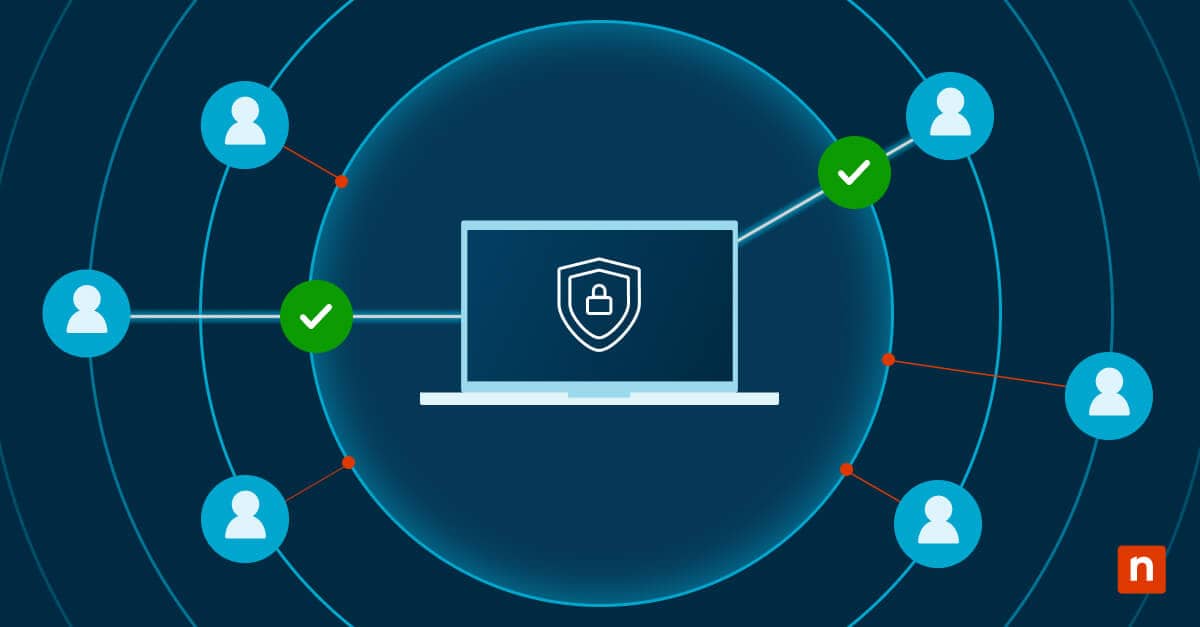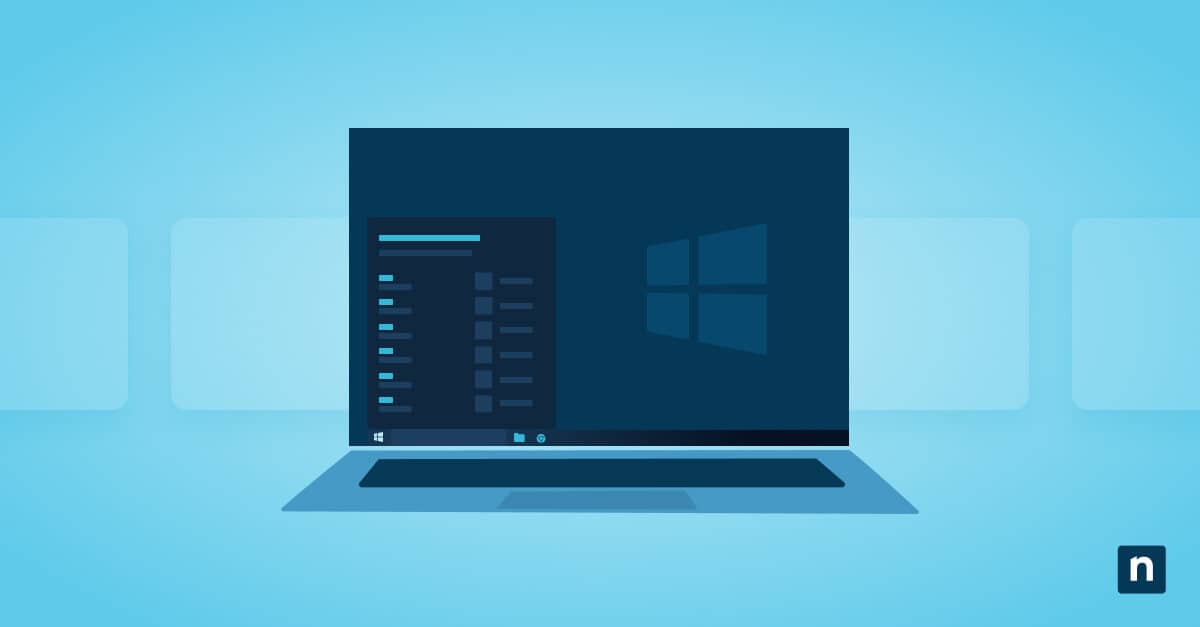While often overlooked, strong IT documentation can be the difference between hours, potentially days, of downtime and smooth operation. To avoid these costly missteps, IT leaderships and MSPs are turning to IT documentation software to record data and process contextual information that can be used to improve IT infrastructures and compliance.
But with the numerous solutions out there, which tool is the most suitable for your organization? That’s where we come in. We’ve created this list of the best IT documentation software based on genuine user assessments from leading review sites, along with each tool’s user-friendliness and robustness.
🥷🏼 NinjaOne standardizes your IT knowledge base, so you work faster and smarter.
Learn more about NinjaOne IT Documentation today.
Best IT documentation at a glance
| Name of Software | Key Features | Trial Information |
| NinjaOne | Remote monitoring and management, patch management, automation | 14-day free trial |
| IT Glue* | IT documentation, password management, asset tracking | No free trials available |
| ClickUp | Task and project management, goal tracking | Free plan available |
| Hudu | IT documentation, password manager, asset management | 14-day free trial |
| Confluence | Team collaboration, knowledge base, project management | Free plans available |
| Document360 | Knowledge base software, markdown editor, version control | 14-day free trial |
*NinjaOne has integrations with IT Glue.
Table of Contents:
What is IT Documentation?
IT documentation is a centralized accounting of all of the devices, software, directory structures, user profiles, data, and frameworks used to manage and organize an IT environment. This documentation can be distilled into many forms but should tell you what something is, how something is done, why it’s done that way, and when something is supposed to happen.
What is IT Documentation Software?
IT documentation software refers to the actual tools used to conduct the documentation or automate some steps. Tools range in complexity from relatively simple and free solutions like Google Docs or OneNote to more specialized solutions like NinjaOne IT Documentation or IT Glue.
Important components of IT documentation software solutions
💡 It’s worth noting that the best IT documentation software is the one that most aligns with your organization’s operational goals. The components listed below should only serve as a guide in your decision-making process and should not prevent you from using the documentation tool your IT team prefers.
The top IT documentation solutions offer eight key features:
- Centralized documentation: A good IT documentation tool acts as a single source of truth that consolidates all IT knowledge, such as network diagrams, SOPs, and asset records, into one accessible location. This allows your IT team (whether in-house or remote) to work with the same up-to-date data.
- Search functionality: It’s important that you can quickly and accurately search for keywords.
- Access controls and permissions: Robust access controls let administrators define who can view, edit, or manage specific documents. This ensures that only authorized team members can access privileged information.
- Integration with other IT tools: The top documentation tools for IT professionals integrate seamlessly with other key platforms like RMM software. This connectivity is not only cost-effective, but it can also dramatically improve operational efficiency.
- Automated documentation: This helps eliminate manual error (and reduce the risk of human error) by pulling data directly from systems or third-party tools. Automated documentation likewise ensures the accuracy of and consistency of your documentation.
- Cost Savings: Whether it’s savings from time spent on new employee onboarding or efficiencies due to a standard operating procedure, IT documentation has a direct impact on an organization’s bottom line. The cost of IT documentation software is worth it for the positive benefits it offers.
- Improved Support Operations: When a technician can access a record of past actions taken on a device or view what a normal state should look like, their job is made easier and the end-user experience is improved. Many IT documentation software providers offer an API to extract data which can then be used by support teams and other platforms. Others have natively integrated IT documentation into support operations, such as Ninja Ticketing.
- Integrated Security: Proper IT documentation can be a valuable tool for improving an organization’s security hygiene by documenting patching schedules and instructions, storing passwords and admin credentials, and setting up security checks throughout a process, among other things.
6 Best IT documentation software solutions
All G2 & Capterra data as of May 2025.
1. NinjaOne
NinjaOne, an automated endpoint management software solution, is trusted by 20,000+ customers worldwide for its proven capabilities of increasing productivity, reducing security risks, and lowering costs from day one. It delivers radical efficiency by automating the hardest parts of IT in a cloud-native platform that simplifies endpoint management, patching, and visibility for environments at any scale.
Built into NinjaOne’s core platform, NinjaOne Documentation is a full-fledged IT documentation solution that provides a seamless documentation experience. NinjaOne allows users to document everything within their IT environment in a standardized, structured form to easily collect and use data. To make it easier for users to start documenting critical information, NinjaOne provides out-of-the-box documentation templates for active directory, security, and vendor management. Documentation data is accessible via scripts and the NinjaOne API.
Other notable features:
- NinjaOne Documentation lets you find answers in seconds, not hours.
- It eliminates knowledge silos and tribal knowledge by allowing IT pros to create a single source of truth for credentials, workflows, assets, and more.
- Securely stores and shares credentials in a single platform, avoiding plain-text storage.
- Enforces authentication before accessing any secure field.
- Provides contextual information about processes, devices, users, and security.
Experience unmatched IT documentation management when and where you need it.
Discover NinjaOne Documentation.
What users say
Darwish Baganian, the Infrastructure and IT security manager of Seraphine, was looking for an all-in-one platform that could optimize his team’s IT stack. With NinjaOne, he was able to monitor, manage, and secure his endpoints and even reduce the time spent on security reports by 30%.
“NinjaOne has all the third-party integrations, remote access, reporting, and patching features we need,” said Baganian. “By month two, NinjaOne’s robust remote features and automatic documentation reduced our average ticket resolution time by 15%.”
Read more NinjaOne customer stories or check out NinjaOne reviews.
NinjaOne reviews on G2
| Category | NinjaOne Rating |
| Overall | 4.7 out of 5 (1,866) |
| Has the product been a good partner in doing business? | 9.5 |
| Quality of support | 9.2 |
| Ease of Admin | 9.2 |
| Ease of Use | 9.2 |
NinjaOne reviews on Capterra
| Category | NinjaOne Rating |
| Overall | 4.8 out of 5 (246) |
| Ease of Use | 4.7 |
| Customer Support | 4.7 |
| Functionality | 4.5 |
| Value for Money | 4.6 |
2. IT Glue
IT Glue is a dedicated IT documentation software solution that integrates into many popular RMM and PSA platforms**. IT Glue helps users find, track, and manage all knowledge within an IT environment. The company is owned by Kaseya.
It is a well-known IT documentation software that lets you track, find, and know everything about your IT environment. It is a robust solution that provides structured documentation, from IT asset, vendor and software information to passwords, contacts, and SOPs, all in a single pane of glass.
Trial information
No free trials are available. You can, however, sign up for a free demo.
Features
- Integrations: This IT documentation tool integrates with major PSA, RMM, BDR, and other platforms.
- Enterprise-grade security: IT Glue is SOC 2 compliant and offers multiple security features.
- Automated account backup: The tool automatically backs up your account so you always have access to your most up-to-date data.
Shortcomings
- Search function: According to some G2 users, the search function of IT Glue is not intuitive or expressly logical.
- Granular permissions: IT Glue users have stated that the platform lacks granular permissions, which makes password management challenging.
- Performance: Some users have stated that the IT Glue mobile app can be slow at times.
*NinjaOne has integrations with IT Glue.
IT Glue reviews on G2
| Category | IT Glue Rating |
| Overall | 4.7 out of 5 (604) |
| Has the product been a good partner in doing business? | 9.0 |
| Quality of support | 8.8 |
| Ease of Admin | 9.0 |
| Ease of Use | 9.1 |
IT Glue reviews on Capterra
| Category | IT Glue Rating |
| Overall | 4.6 out of 5 (302) |
| Ease of Use | 4.6 |
| Customer Support | 4.4 |
| Functionality | 4.5 |
| Value for Money | 4.5 |
3. ClickUp
ClickUp is a popular and versatile project management platform that offers dozens of functionalities to streamline organizational tasks. While it is not a dedicated IT documentation tool, we included it in this list because the platform provides flexibility for teams looking to combine documentation with task and project management in a single system.
In particular, ClickUp’s Docs feature allows you to create structured documentation within the platform, supporting elements like headers, tables, code blocks, and internal linking. Documents can then be organized into nested folders, shared across teams, and linked directly to tasks or projects for added context.
Trial information
Free plan available
Features
- Everything view: ClickUp offers the Everything view, which gives you a bird’s eye view for all tasks across every level of your organization.
- Folder, space, and list management: You can organize teams and departments into spaces, group big projects into folders, and break out tasks into lists for a clearer view.
- Customizable tasks: ClickUp lets you choose from over 30 apps to customize your task management.
Shortcomings
- Performance: G2 users have stated that ClickUp can slow down, especially when documentation becomes more varied and extensive.
- Learning curve: The platform does have a learning curve, particularly for beginner IT personnel who are not used to project management tools.
- Mobile app: According to some users, ClickUp’s mobile app could be improved to be more user-friendly.
ClickUp reviews on G2
| Category | ClickUp Rating |
| Overall | 4.7 out of 5 (10,210) |
| Has the product been a good partner in doing business? | 9.0 |
| Quality of support | 8.9 |
| Ease of Admin | 8.6 |
| Ease of Use | 8.5 |
ClickUp reviews on Capterra
| Category | ClickUp Rating |
| Overall | 4.6 out of 5 (4,455) |
| Ease of Use | 4.3 |
| Customer Support | 4.5 |
| Functionality | 4.6 |
| Value for Money | 4.6 |
4. Hudu
Hudu is one of the top IT documentation solutions for MSPs and IT teams. It offers a structured environment for organizing client information, including SOPs, network documentation, credentials, and asset details. One of its strengths is its client-based architecture that allows you to segment documentation by organization, making it easier to manage multi-tenant environments.
In addition, Hudu includes features like a built-in password manager and integrations with RMM and PSA tools.
Trial information
14-day free trial
Features
- Asset management: Hudu allows you to manage and track all your resources in a centralized dashboard.
- Password management: The IT documentation tool’s built-in password management creates, manages, and securely shares credentials.
- Process organization: Hudu helps you create repeatable processes to standardize your SOPs across your organization.
Shortcomings
- User-friendliness: According to some G2 users, Hudu’s UI is not always intuitive.
- Update documentation: Some G2 users have stated that occasionally, new features are added to Hudu but are not well-documented, leading to initial confusion.
- Customization: Currently, Hudu is limited in how customizable its alerting system is.
Hudu reviews on G2
| Category | Hudu Rating |
| Overall | 4.7 out of 5 (158) |
| Has the product been a good partner in doing business? | 9.5 |
| Quality of support | 9.2 |
| Ease of Admin | 9.2 |
| Ease of Use | 9.2 |
Hudu reviews on Capterra
| Category | Hudu Rating |
| Overall | 4.6 out of 5 (5) |
| Ease of Use | 4.8 |
| Customer Support | 4.2 |
| Functionality | 4.2 |
| Value for Money | 4.8 |
5. Confluence
Confluence is a widely used collaboration and documentation tool developed by Atlassian. It allows teams to create, organize, and share internal documentation such as knowledge bases, onboarding guides, and standard operating procedures. Pages are organized in a hierarchical structure within spaces, and the platform supports version history, inline comments, and collaborative editing, which makes it suitable for distributed teams working on shared content.
Although Confluence is not specifically built for IT documentation, it is often adopted by IT departments due to its flexibility and integration with other Atlassian tools like Jira. However, it lacks built-in features tailored to IT operations, such as automated asset tracking or password management.
Trial information
Free plans available
Features
- Integrations: Confluence integrates with several other tools.
- Data protection: The platform features various security measures.
- Real-time editing: Users can edit content with the whole team simultaneously.
Shortcomings
- Search limitations: According to some G2 users, the search functionality in Confluence is a little difficult to use.
- Learning curve: The platform takes time to learn and master.
- Customization: Currently, Confluence does not offer many out-of-the-box and customizable templates.
Confluence reviews on G2
| Category | Confluence Rating |
| Overall | 4.1 out of 5 (3,799) |
| Has the product been a good partner in doing business? | 8.4 |
| Quality of support | 8.0 |
| Ease of Admin | 7.9 |
| Ease of Use | 7.9 |
Confluence reviews on Capterra
| Category | Confluence Rating |
| Overall | 4.5 out of 5 (3,597) |
| Ease of Use | 4.2 |
| Customer Support | 4.3 |
| Functionality | 4.4 |
| Value for Money | 4.3 |
6. Document360
Document360 is a knowledge base platform designed to help teams create, manage, and publish documentation in a searchable format. It supports markdown editing, version control, category-based organization, and granular access permissions, making it suitable for internal IT documentation as well as public-facing knowledge bases.
While it does not offer IT-specific capabilities like asset management of RMM integrations, it’s a solid choice for organizations looking for a standalone documentation system with strong authoring and publishing tools.
Trial information
14-day free trial
Features
- Analytics: Offers a wide range of analytics, including content consumers’ geographic location
- Integrations: Document360 integrates with several help desks, chatbots, and CRO tools.
- SEO: The platform helps you create SEO-friendly knowledge base articles.
Shortcomings
- Editing: Some G2 users have said that editing an article can be difficult, especially as the platform occasionally glitches.
- Commenting: The commenting function can be challenging at times and is not as user-friendly as expected.
- Bugs: Many G2 users have experienced various types of bugs in the software, ranging from issues with analytics to inaccessible features, that occur randomly.
Document360 reviews on G2
| Category | Document360 Rating |
| Overall | 4.7 out of 5 (438) |
| Has the product been a good partner in doing business? | 9.5 |
| Quality of support | 9.6 |
| Ease of Admin | 9.1 |
| Ease of Use | 9.3 |
Document360 reviews on Capterra
| Category | Document360 Rating |
| Overall | 4.7 out of 5 (238) |
| Ease of Use | 4.7 |
| Customer Support | 4.8 |
| Functionality | 4.5 |
| Value for Money | 4.5 |
Comparison of best IT Documentation Software (G2)
| Category | NinjaOne | IT Glue | ClickUp | Hudu | Confluence | Document360 |
| Overall | 4.7 out of 5 (1,866) | 4.7 out of 5 (604) | 4.7 out of 5 (10,210) | 4.7 out of 5 (158) | 4.1 out of 5 (3,799) | 4.7 out of 5 (438) |
| Has the product been a good partner in doing business? | 9.5 | 9.0 | 9.0 | 9.5 | 8.4 | 9.5 |
| Quality of support | 9.2 | 8.8 | 8.9 | 9.2 | 8.0 | 9.6 |
| Ease of Admin | 9.2 | 9.0 | 8.6 | 9.2 | 7.9 | 9.1 |
| Ease of Use | 9.2 | 9.1 | 8.5 | 9.2 | 7.9 | 9.3 |
Comparison of best IT Documentation Software (Capterra)
| Category | NinjaOne | IT Glue | ClickUp | Hudu | Confluence | Document360 |
| Overall | 4.8 out of 5 (246) | 4.6 out of 5 (302) | 4.6 out of 5 (4,455) | 4.6 out of 5 (5) | 4.5 out of 5 (3,597) | 4.7 out of 5 (238) |
| Ease of Use | 4.7 | 4.6 | 4.3 | 4.8 | 4.2 | 4.7 |
| Customer Support | 4.7 | 4.4 | 4.5 | 4.2 | 4.3 | 4.8 |
| Functionality | 4.5 | 4.5 | 4.6 | 4.2 | 4.4 | 4.5 |
| Value for Money | 4.6 | 4.5 | 4.6 | 4.8 | 4.3 | 4.5 |
Why use IT documentation software? Some use cases
Many industries are already subject to stringent standards when it comes to documentation and reporting. Let’s look at some scenarios where IT documentation can help bridge the gap between you and these regulatory requirements.
Internal audits
Industries such as pharmaceuticals, hospitality, finance, and IT services are subject to strict international standards. A high-quality documentation and reporting structure help expedite auditing and reduce the risk of oversight among your ranks. It will also keep quality control at a high level, which is the subject of various ISO compliance requirements.
Data security
Security standards (e.g., GDPR, DORA) are constantly updated and refined, especially in industries that handle sensitive customer information. It’s impossible to meet these international guidelines without strong IT documentation protocols. More so if you lack the IT documentation software to keep up.
Project management
Industries that frequently work with numerous stakeholders and third-party services will greatly benefit from modern IT documentation software. Apart from being able to organize assets and automate certain tasks, advanced documentation will improve collaboration and transparency between stakeholders.
Common IT documentation challenges
The benefits of IT documentation can’t be understated. The time and efficiency savings of good documentation can easily pay for itself but getting it right requires overcoming some common challenges.
Incomplete documentation
There’s nothing more frustrating than referencing a piece of documentation and then finding out that only half of the steps were documented.
Even worse, not having any documentation in the first place. In either case, technicians end up spending their time and resources creating new documentation and recreating the wheel to find a workable solution.
IT documentation software can standardize processes and automate certain steps in documentation, which frees up IT specialists to take on more urgent tasks.
Outdated or low-quality documentation
In a similar vein, another documentation challenge that IT pros will run into is out-of-date documentation.
This usually occurs when teams fail to periodically review and edit documentation to reflect new standards such as patching schedules, approved software, or configurations for setting up a new user.
Both of these challenges can contribute to a negative feedback loop of low trust in the reporting and validation process, and therefore less active management and collaboration in creating high-quality documentation.
Lack of standardization across teams
A lack of standardized templates and documentation guidelines can become messy very quickly. Think about it: One person might write a detailed SOP, while another merely jots down a vague outline. This inconsistency makes it harder for others to interpret or reuse the documentation later on. This becomes especially true if you work in complex environments that requires detailed documentation.
Even so, keep in mind that standardization doesn’t mean rigid conformity. Rather, it’s about implementing a consistent format for capturing critical information like steps, configurations, credentials, and related resources. This reduces confusion and improves knowledge sharing across teams.
Limited participation
Getting team-wide participation in documentation efforts can also be a major hurdle. Technicians are often under pressure to resolve issues quickly, and documentation can fall to the bottom of the priority list. However, this seemingly “time-saving” technique can lead to trouble in the future.
One way to address this is to assign specific documentation areas and build documentation KPIs into performance reviews or team goals. When documentation is seen as a shared responsibility and integrated into daily operations, as opposed to a separate and entirely optional task, it becomes a natural part of how your IT team functions. IT documentation tools can make the process easier and improve adoption rates.
Finding the best IT documentation management tool
IT documentation can’t be ignored if your goal is to increase IT efficiency and productivity. Without documentation, patching schedules could be missed, important server configurations could be lost, and it can take new hires more time to get up and running.
In today’s modern IT environment, good documentation is the backbone of any organization and a key requisite for growth. To continue meeting the needs of today’s businesses, specialized IT documentation software has emerged to streamline and automate important parts of the documentation process while making the data more usable.
NinjaOne’s IT management software has no forced commitments and no hidden fees. If you’re ready, request a free quote, sign up for a 14-day free trial, or watch a demo.






